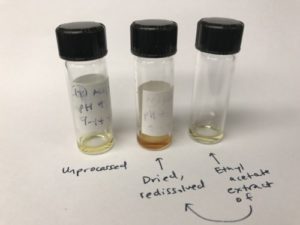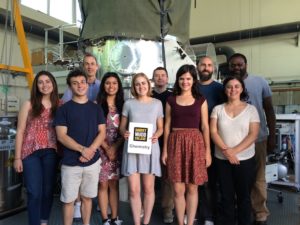Lelia N. Hawkins Research
Research in Hawkins lab aims to address the general question, “How does air pollution affect climate and anthropogenic climate change?”
Listen to recent interviews with Professor Hawkins:
“Has the Coronavirus Shutdown Improved Air Quality?” The Pulse-WHYY (PBS), May 15, 2020
“How the Pandemic is Changing Air Pollution Levels” CBS Sunday Morning, April 29, 2020
“Stay-At-Home Order Reduces Air Pollution, Offers Clues in Climate Change Fight” capradio, April 14, 2020
To address this question, students work in one of four major areas:
- ambient measurement of LA air pollution in real-time,
- simulation of brown carbon compounds and their atmospheric changes in bulk samples,
- mapping local particulate matter with mobile sensors, and
- simulation of brown carbon compounds in an atmospheric cloud chamber in Paris, France.
If you are an undergraduate student at any of the Claremont Colleges, you are encouraged to email Professor Hawkins at hawkins@g.hmc.edu to set up an in-person conversation regarding research opportunities (including senior thesis) and to consider applying for chemistry research in the annual January department call.
There are sometimes opportunities for students outside the Claremont Colleges to participate in research in her program, but these are rare. Even so, you are welcome to contact Professor Hawkins about any possible opportunities and to apply for research in the January department call. Professor Hawkins is unable to accommodate requests for research from current high school students and graduate students looking for postdoctoral opportunities at this time.
Active Research
(1) Measuring particulate matter composition and color in Los Angeles
We use an Aerodyne aerosol mass spectrometer to obtain continuous information about aerosol amount and composition for up to several months at a time. An optical spectrometer connected with a specialized particle sampler provides a measure of aerosol color and the intensity of absorbance. Particle sizing and counting instruments provide insight into the microphysical properties of aerosol particles. Together, these online instruments allow students to answer questions about the sources of air pollution and their relative importance using statistical analyses designed for time series. [Well-suited to chemistry, engineering, math, and computer science majors. Academic year work is mostly data analysis.]
(2) Laboratory simulations of chromophore formation in cloud water

Light absorbing compounds in aerosol comes from a variety of sources. Some are emitted in wildfires, others are generated in atmospheric reactions from non-absorbing precursors. Projects in this category combine UV/visible absorbance spectroscopy with mass spectrometry to characterize the products and properties of key browning reactions under atmospherically relevant conditions like variable pH, oxidation by radicals, and evaporation of cloud/fog droplets. [Well-suited to chemistry majors]
(3) Intelligent air quality sampling with mobile sensor networks (a collaboration with Prof. Chris Clark, Engineering)
How clean is my air? This question could be answered with greater spatial resolution in air quality measurements. And as online instruments for gas and aerosol phase air pollutants become more rapid, sensitive, and robust, interest in mobile sampling has dramatically increased. Mobile platforms provide much richer and more useful datasets for addressing particulate mass (PM) and ozone exposure than stationary sites because they capture both spatial and temporal variability in air quality. Mobile sampling adds flexibility to campaigns through the use of both ad hoc and algorithm-based redirection.
However, to our knowledge current mobile sampling studies are lacking two key features that this interdisciplinary and collaborative work addresses: path planning and extrapolation to non-sampled regions. This project involves validation of:
- the fixed rank filtering method’s ability to fuse particle count measurements,
- the multi-resolution planner’s ability to scale well with increased graph size and function even in real-time, and
- the system’s applicability to a real vehicle deployment for real data collection. [Well-suited to engineering and computer science majors as well as chemists with additional coursework]
(4) Studying pollution chemistry in an atmospheric cloud chamber at the University of Paris, Creteil, France

This project expands the bulk laboratory simulations of chromophore formation to droplet phase experiments in an atmospheric simulation chamber (CESAM)housed at the University of Paris, in Creteil, France. Gases and particles are introduced into the chamber and clouds and/or sunlight can be simulated to understand the role of atmospheric variables in brown carbon formation. This work is a collaboration with the University of San Diego and LISA at the University of Paris. Students working on this project spend one summer month living in Paris and working at the University of Paris lab in Creteil. The remainder of the summer is spent at HMC on either preparation or data analysis.